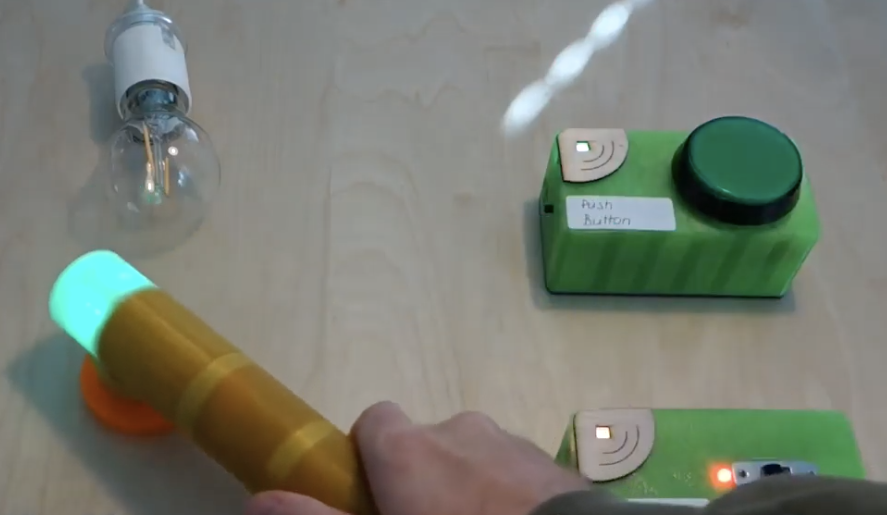Posts with «internet of things» label
Smarter Serial Communications with WiSer
Mighty Modules: Pluggable Boards To Get Your Project Built

If you're taking your microcontroller or SBC project to market, these pluggable boards might be what you need.
The post Mighty Modules: Pluggable Boards To Get Your Project Built appeared first on Make: DIY Projects and Ideas for Makers.
Microcontrollers, Meet MicroBlocks
 Physical Computing Software For Education That Runs Live, On The Microcontroller
Physical Computing Software For Education That Runs Live, On The Microcontroller
The post Microcontrollers, Meet MicroBlocks appeared first on Make: DIY Projects and Ideas for Makers.
Home Safety Monitoring With IoT
Home automation is a popular project to undertake but its complexity can quickly become daunting, especially if you go further than controlling a few lights (or if you’re a renter). To test the waters you may want to start with something like this home safety monitor, which is an IoT device based on an Arduino. It allows remote monitoring of a home for things such as temperature, toxic gasses, light, and other variables, which is valuable even if you don’t need or want to control anything.
The device is built around an Arduino Nano 33 IOT which has WiFi and Bluetooth capabilities as well as some integrated security features. This build features a number of sensors including pressure/humidity, a gas/smoke detector, and a light sensor. To report all of the information it gathers around the home, an interface with Ubidots is configured to allow easy (and secure) access to the data gathered by the device.
The PCB and code for the project are all provided on the project page, and there are a number of other options available if Ubidots isn’t your preferred method of interfacing with the Internet of Things. You might even give Mozilla’s WebThings a shot if you’re so inclined.
3 Reasons You Should Register For Maker Faire Shenzhen Now
 This year, Maker Faire Shenzhen 2019 will be focusing on the theme “To the Heart of Community, To the Cluster of Industry”. With a full chain events for technological innovations, you can look forward to the Maker Summit Forum, Maker Booths (includes highlights and performances), as well as Innovation workshops. […]
This year, Maker Faire Shenzhen 2019 will be focusing on the theme “To the Heart of Community, To the Cluster of Industry”. With a full chain events for technological innovations, you can look forward to the Maker Summit Forum, Maker Booths (includes highlights and performances), as well as Innovation workshops. […]
The post 3 Reasons You Should Register For Maker Faire Shenzhen Now appeared first on Make: DIY Projects and Ideas for Makers.
Program smart devices with a ‘magic wand’

Consider how interactive devices have come to dominate our lives. Once the purview of a select few in large laboratories, powerful gadgets—supercomputers even—are carried with us everywhere we go in the form of smartphones. And as everything around us becomes increasingly more connected, those that have no interest in the technical aspects of computing will still need to know how to configure the networked things throughout their homes.
As an experiment in interactive design, Austrian researchers Florian Güldenpfennig, Daniel Dudo, and Peter Purgathofer have come up with a ‘Magic Paradigm’ for programming.
Their project uses a wand with a built-in RFID reader, allowing it to sense which RFID tagged object it’s pointing to and register various sequences. This enables devices to be customized as needed, many of which contain an Arduino Nano as ‘active’ units and an nRF24L01+ module for communication. A central desktop/Arduino setup is also implemented to coordinate system elements.
We are surrounded by an increasing number of smart and networked devices. Today much of this technology is enjoyed by gadget enthusiasts and early adaptors, but in the foreseeable future many people will become dependent on smart devices and Internet of Things (IoT) applications, desired or not. To support people with various levels of computer skills in mastering smart appliances as found, e.g., in smart homes, we propose the ‘magic paradigm’ for programming networked devices. Our work can be regarded as a playful ‘experiment’ towards democratizing IoT technology. It explores how we can program interactive behavior by simple pointing gestures using a tangible ‘magic wand’. While the ‘magic paradigm’ removes barriers in programming by waiving conventional coding, it simultaneously raises questions about complexity: what kind of tasks can be addressed by this kind of ‘tangible programming’, and can people handle it as tasks become complex? We report the design rationale of a prototypical instantiation of the ‘magic paradigm’ including preliminary findings of a first user trial.
4 Ways to Control Electronic Relays
 There are plenty of ways to use relays, and each method can achieve several different results. Check out this step by step guide to figure out what you need.
There are plenty of ways to use relays, and each method can achieve several different results. Check out this step by step guide to figure out what you need.
The post 4 Ways to Control Electronic Relays appeared first on Make: DIY Projects and Ideas for Makers.
Learning Microcontrollers and Robotics in the DroneBot Workshop
 Discover an excellent YouTube channel for learning hobby electronics, microcontrollers, robotics, and drones.
Discover an excellent YouTube channel for learning hobby electronics, microcontrollers, robotics, and drones.
The post Learning Microcontrollers and Robotics in the DroneBot Workshop appeared first on Make: DIY Projects and Ideas for Makers.
Livestream-Interactive Confetti Cannon
The post Livestream-Interactive Confetti Cannon appeared first on Make: DIY Projects and Ideas for Makers.


